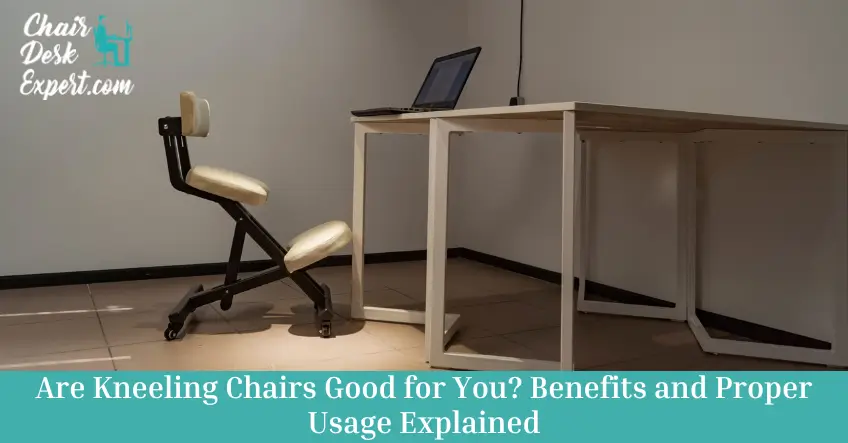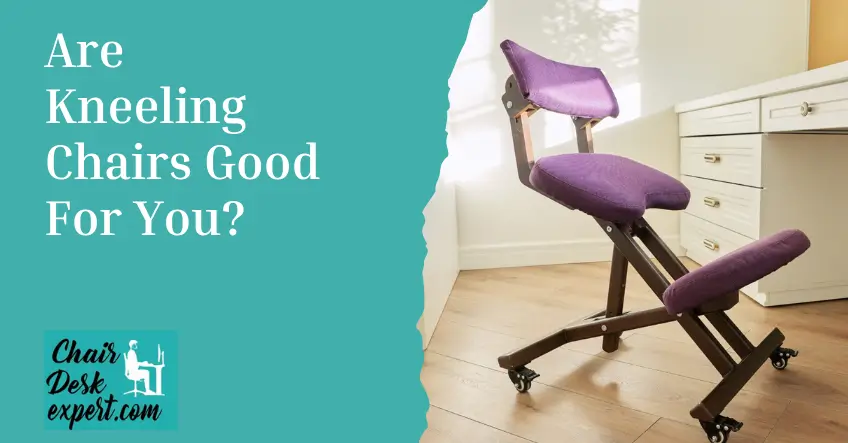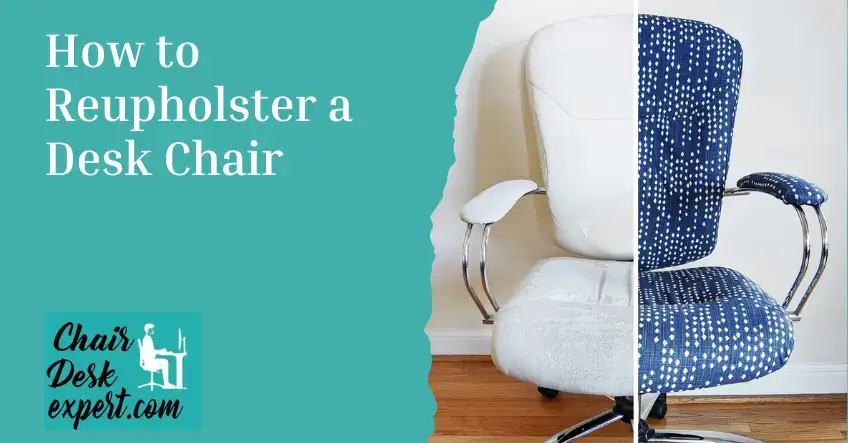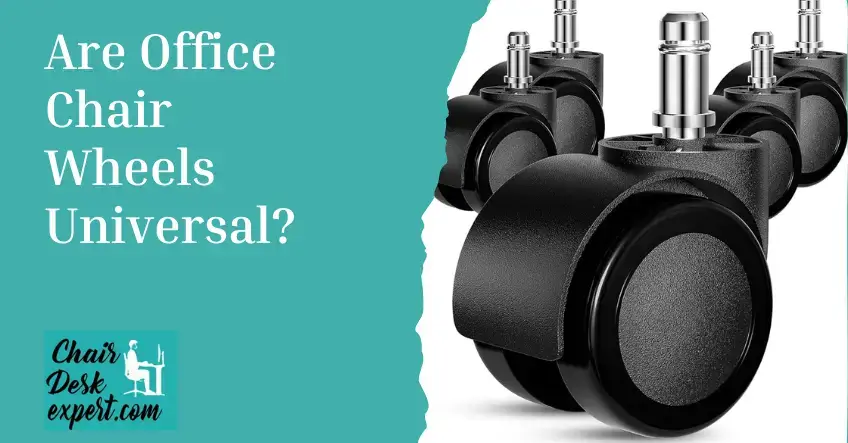Sitting still and slumped in a poor chair for extended periods each day can lead to severe musculoskeletal issues that affect various aspects of life, including work performance and personal well-being.
That’s why it’s crucial to carefully select office equipment, including chairs, with expert guidance. Like conventional seating, distinguishing between well-designed kneeling chairs and inferior models is essential for promoting proper posture and comfort.
This article aims to provide all the necessary details about Are kneeling chairs good for you, keep reading to get detailed knowledge.
Are Kneeling Chairs Good for You? Benefits and Proper Usage Explained

Kneeling chairs offer unique advantages for posture and comfort, but proper usage is critical to maximizing their benefits.
Let’s find out: Are kneeling chairs good for you and how to use them correctly for optimal results.
What Is a Kneeling Chair?
A kneeling chair is a type of ergonomic seating designed to promote better posture and reduce lower back strain compared to traditional office chairs.
It features a unique design with two cushioned pads—one for the buttocks and another for the shins. Unlike conventional chairs, in which the feet touch the ground, in a kneeling chair, the feet typically do not feel the floor.
The absence of a backrest encourages users to shift their body weight onto the knees and shins, which helps distribute body weight more evenly and reduces pressure on the lower back and thighs.
With a kneeling chair, the angle between the lower back and thighs is widened to around 60 or 70 degrees, compared to the 90-degree angle in standard office chairs. This altered sitting posture can alleviate strain on the lower back and encourage better spinal alignment.
By engaging core muscles and encouraging a more active sitting position, kneeling chairs can help strengthen muscles and improve overall posture.
These chairs are often designed to be compact and easily stored under desks, contributing to a neat and organized office environment.
|| Read Also This: Top Kneeling Chair for Short Stature
Are Kneeling Chairs a Good Choice?
Kneeling chairs, particularly rocking versions, can be a beneficial choice for individuals seeking to improve posture, increase movement, and reduce the adverse effects of prolonged sitting.
Here’s why kneeling chairs are often considered a good option:
Encourages Movement:
Unlike traditional static chairs that promote sedentary behaviour, kneeling chairs, especially rocking ones, encourage active sitting.
This dynamic sitting posture helps prevent stiffness and enables more natural movement throughout the day.
Relieves Pressure:
Kneeling chairs distribute body weight differently than standard chairs, which can help relieve pressure on the lower back and spine. This can be particularly beneficial for individuals prone to back discomfort or pain.
Promotes Better Posture:
Kneeling chairs can facilitate a more upright posture by tilting the pelvis forward and opening the hip angle, reducing strain on the spine and improving overall alignment.
Increases Core Engagement:
Sitting on a kneeling chair engages the core muscles as they work to stabilize the body in an upright position. This continuous activation can contribute to core strength and stability over time.
Prevents Prolonged Static Sitting:
Prolonged static sitting can negatively impact metabolism and overall health. A kneeling chair encourages regular movement and prevents extended periods of stillness, which can help maintain metabolic activity.
Suitable for Various Tasks:
Kneeling chairs are versatile and ideal for various tasks, including computer work, writing, drawing, and other activities that may require leaning forward. They can be paired with desk slopes for optimal ergonomics.
Customizable and Durable:
Quality kneeling chairs accommodate different body types and desk heights. They are designed to be durable and provide long-lasting support for daily use.
Enhances Workspace Ergonomics:
Incorporating a kneeling chair into your workspace setup can complement other ergonomic furniture and equipment, creating a more ergonomic and movement-friendly environment.
Improved Pelvic and Hip Position:
Kneeling chairs promote better spine, back, neck, and shoulder alignment by opening the hips and pelvis. This encourages better posture and reduces pressure on internal organs, potentially improving digestion.
Core and Back Muscle Development:
A kneeling chair engages back and abdominal muscles because there is no backrest for support. Over time, this can lead to stronger core and back muscles, enhancing overall posture.
Reduced Pressure on Spine and Back:
Unlike traditional office chairs that can encourage slouching and strain on the spine, kneeling chairs help alleviate pressure on the back and neck. This can reduce the risk of developing back pain and circulation issues.
Enhanced Focus and Reduced Distraction:
By minimizing discomfort and pain associated with poor sitting posture, kneeling chairs can help improve focus and concentration at work, reducing distractions caused by bodily discomfort.
Promotes Better Posture:
The angled seat of a kneeling chair (typically set at 20 to 30 degrees) helps to naturally maintain the ‘S’ curve of your spine, facilitating improved posture and even distribution of body weight.
Prevents Slouching:
Unlike traditional office chairs that often encourage slouching, kneeling chairs lack a backrest, which inherently discourages slouching and helps protect the spine from prolonged poor posture.
Space-Efficient Design:
Kneeling chairs are compact and occupy minimal space, making them ideal for smaller office setups. Their portability allows for easy movement and placement within different work environments.
Cost-Effective Option:
Compared to many other expensive ergonomic chairs, kneeling chairs are a cost-effective alternative. They offer ergonomic benefits at a more affordable price point, typically ranging from $70 to $90, making them accessible to a broader range of users.
It’s important to note that acclimatization to a kneeling chair may be needed, especially for those transitioning from traditional seating.
Additionally, individual preferences and tasks should be considered when selecting the type of kneeling chair that best suits one’s needs.
Overall, a well-chosen kneeling chair can be a valuable addition to promote active and healthier sitting habits throughout the workday.
|| Read Also This: Best Kneeling Office Chair
How to Sit on a Kneeling Chair

To sit correctly on a kneeling chair and optimize its benefits for posture and comfort, follow these steps:
Initial Sitting Position:
Begin by sitting on the kneeling chair as you would on a regular chair. Position your bottom comfortably on the seat and place your feet on the floor.
Adjust for Comfort:
- Take a moment to adjust your position until you feel comfortable and well-supported.
Position Your Legs:
- Lift your lower legs and position your knees on the padded area on the kneeling chair.
Maintain Proper Weight Distribution:
Ensure that most of your body weight is still supported by your bottom rather than placing excessive weight on your knees. The kneeling position is designed to distribute some weight away from your lower back.
|| Read Also This: Are Kneeling Chairs Good For Sciatica Pain Relief?
Allow Time to Adapt:
Understand that this new seating position may feel unusual initially as your muscles adjust to the different positions.
Over time, consistent use of the kneeling chair will help you find a comfortable and neutral sitting posture.
Adjust Chair Height (if needed):
If you are tall and find the shin pads uncomfortable, most kneeling chairs are adjustable. Modify the height of the chair to better suit your leg length.
Regularly Switch Positions:
Alternate between different seating options throughout the day to promote movement and prevent stiffness.
Start with both knees on the pads, then try resting one leg while keeping the other on the pad, and switch sides periodically.
Incorporate Standing Desk (if available):
Whenever possible, integrate periods of standing at a standing desk into your work routine. This variety of postures helps keep your body active and engaged throughout the day.
|| Read Also This: Discover (Innovative) Comfort: What is a Kneeling Chair?
What Is the Proper Way to Use a Kneeling Chair?
Using a kneeling chair properly maximizes its benefits and avoids discomfort. Here are tips on the proper way to use a kneeling chair:
Gradual Adjustment:
If you’re new to using a kneeling chair, allow your body time to adapt. Start using the kneeling chair for short periods and gradually increase the duration over days and weeks. Alternate between your existing office chair and the kneeling chair to ease into the transition.
Weight Distribution:
When seated in a kneeling chair, most of your body weight should be supported by your bottom on the seat pad.
The lower pad (or shin rest) is there to provide support for your shins and prevent them from sliding forward.
Sitting Position:
Begin by sitting on the seat of the kneeling chair with your buttocks positioned towards the backrest. Place your knees gently on or slightly above the kneeling pads, maintaining a comfortable and stable posture. Avoid putting excessive weight or pressure on your knees.
Variation and Movement:
Just like with any working position, it’s essential to vary your posture and movement throughout the day. The design of a rocking kneeling chair encourages subtle rocking and swivelling motions, which can help prevent stiffness and promote circulation. Alternate which leg is positioned forward periodically to balance muscle engagement.
Comfort and Ergonomics:
Ensure that the height of the kneeling pads is adjusted to a level where your thighs slope slightly downwards, promoting an open hip angle and reducing strain on the lower back backrest of the kneeling chair should provide adequate support to maintain a neutral spine position.
Take Breaks:
Even when using a kneeling chair, taking regular breaks from sitting is essential. Stand up, stretch, and move around periodically to reduce prolonged sitting and promote overall circulation and comfort.
Listen to Your Body:
Pay attention to how your body feels while using the kneeling chair. Adjust the chair’s settings or your sitting position as needed to ensure comfort and proper alignment.
By following these guidelines, you can optimize the use of a kneeling chair and experience its benefits in improved posture, reduced back strain, and increased comfort during prolonged sitting sessions.
Are Your Ergonomically Designed Kneeling Chairs Worth It?
Based on the findings of this research study, it is evident that ergonomically designed kneeling chairs set at +20 degrees inclination significantly influence lumbar curvature compared to standard computer chairs.
The study demonstrated a statistically significant difference between standing lumbar curvature and the lumbar curvature produced by both types of chairs, emphasizing the impact of seating posture on spinal alignment.
The results indicate that sitting on an ergonomically designed kneeling chair is closer to the natural standing lumbar curvature than sitting on a standard computer chair.
This difference in lumbar curvature is attributed to the unique design of kneeling chairs, which promote a wider angle between the lower back and thighs, redistributing body weight and reducing pressure on the lower back.
These findings underscore the potential benefits of ergonomic seating, particularly kneeling chairs, in preventing low back pain and musculoskeletal issues associated with prolonged sitting.
However, further research with a larger and more diverse sample size is recommended to validate these findings across different chair designs and user populations.
Disadvantages of Kneeling Chairs:
Despite their benefits they contain some side effects too.
Restricted Leg Movement:
Kneeling chairs can limit leg flexibility, as the legs hang in a fixed position. Prolonged use in this posture may lead to circulation problems and discomfort due to lack of movement.
Increased Strain on Knees and Shins:
The static leg position in kneeling chairs can strain the knees and shins, potentially causing discomfort or cramping over time, especially during extended periods of use.
Impracticality for Mobility and Reach:
Unlike traditional swivel office chairs, which offer greater mobility and reach, kneeling chairs restrict movement and make tasks such as reaching for objects more challenging due to their elevated leg position.
When to Use an Ergonomic Kneeling Chair:
Short Tasks Requiring Forward Lean:
Use a kneeling chair for short-duration tasks that involve leaning forward, such as drawing, sewing, or typing at a computer. This posture can encourage better alignment and reduce strain on the back during focused activities.
Alternating with Regular Office Chair:
If you find a kneeling chair uncomfortable for extended periods, alternate between using it and a regular office chair throughout the day.
This allows you to benefit from the ergonomic advantages of the kneeling chair without prolonged discomfort.
Acclimating to a New Sitting Position:
Sitting in a kneeling chair may initially feel awkward or stiff as your body adjusts to a different sitting posture. Give yourself time to acclimate to the new position gradually.
Building Core Muscle Strength:
Sitting in a kneeling chair can help strengthen core muscles in the lower back that may have weakened due to prolonged poor posture.
Supplement your sitting with exercises that target core muscle groups to enhance strength and stability further.
Avoid Prolonged Static Positioning:
Avoid prolonged static positioning in a kneeling chair to prevent discomfort and circulation issues. Regularly switch between seating options to promote movement and circulation throughout the day.
Using an ergonomic kneeling chair strategically for specific tasks and alternating with other seating options can maximize its benefits while minimizing potential discomfort associated with prolonged use.
The Final Verdict
So, finally Are kneeling chairs good for you? Whether kneeling chairs are reasonable depends on individual preferences, needs, and comfort levels.
Kneeling chairs offer potential benefits such as improved posture, reduced strain on the lower back, and strengthened core muscles.
However, they may also pose limitations, including restricted leg movement and potential discomfort over extended periods.
For individuals seeking an ergonomic alternative to traditional office chairs, kneeling chairs can be a viable option, particularly for short-term tasks or intermittent use with regular breaks.
Acclimating to a kneeling chair may take time, and it’s essential to listen to your body’s cues and adjust seating arrangements as needed.
Frequently Asked Questions (FAQs)!
1. What are the disadvantages of kneeling chairs?
Kneeling chairs restrict leg flexibility, causing legs to hang without much movement, leading to circulation problems and increased strain on the shins and knees over time.
2. Do doctors recommend kneeling chairs?
Yes, chiropractors often recommend kneeling chairs for better spinal alignment and reduced strain on the lower back, promoting proper posture throughout the day.
3. Are kneeling chairs good for all-day use?
After getting accustomed to rocking kneeling chairs, most people can use them throughout the day. However, static kneeling chairs lack movement and are best suited for very short-term tasks.
4. How long should you sit in a kneeling chair?
Using kneeling chairs intermittently with breaks every two hours is recommended to allow for posture adjustment and prevent overstrain. Kneeling chairs help improve core and back strength over time, benefiting overall posture.
5. Do physiotherapists recommend kneeling chairs?
Yes, physiotherapists endorse kneeling chairs to promote correct lower back positioning and improve overall body posture by training the body to sit with proper alignment.
6. Is a kneeling chair better than a regular chair?
Kneeling chairs offer several health benefits, including improved neck and back strength, enhanced blood circulation, reduced chronic pain in arms and hands, and deeper breathing. Many consider kneeling chairs to promote a healthier posture compared to traditional chairs for working.









